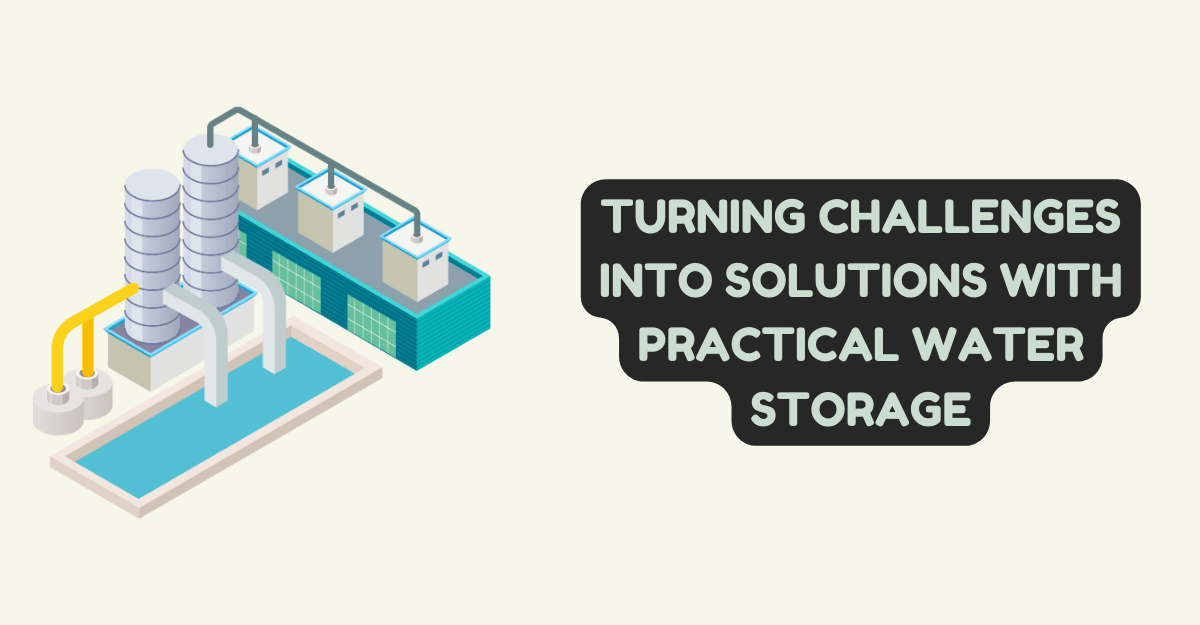
Turning Challenges into Solutions with Practical Water Storage
Have you ever pondered upon the complex nature of water storage and its importance to your livelihood? As water scarcity, climate change and population growth continue to increase across the globe, finding practical water storage solutions has never been more critical.
In this blog post, you will explore how people can turn water storage challenges into sustainable solutions that not only serve communities but also protect your precious environment. The Water Tank Factory is one such entity where you can begin your quest for practical water storage solutions.
Water Storage Challenges Worldwide
From dwindling freshwater resources to problematic infrastructure, the world faces a myriad of water storage challenges. In developing countries, access to clean, safe drinking water often remains elusive due to inadequate storage facilities. Similarly, in developed nations, aging infrastructures create problems. There are treatment plants dating back to the 20th century needing urgent upgrades.
Climate change exacerbates the situation further by disrupting natural freshwater sources. Extreme weather events can cause flooding, contaminating water supplies and damaging storage facilities. Amid these difficulties, devising durable and efficient methods for storing water has become an imperative task.
The United Nations World Water Development Report (UN WWDR) estimates that approximately two billion people worldwide currently live in countries experiencing high water stress. This stark figure underscores the urgency of addressing global water storage problems.
In tackling these challenges, you should take a dynamic approach—incorporating cutting-edge technology with traditional knowledge—thus ensuring water security for future generations while safeguarding the environment against potential damages.
Beneficial Aspects of Water Storage
The benefits of effective water storage systems are manifold. They provide a reliable supply of clean drinking water, support agriculture through irrigation, and can mitigate the impacts of flooding and droughts. Intelligently designed water storage options enable you to harness rainfall and runoff more efficiently.
Diversified water storage systems, ranging from large reservoirs to household rainwater harvesting tanks, can provide a buffer against climate oscillations. These systems are crucial for regions facing irregular rainfall patterns where water scarcity during dry periods is a significant concern.
Additionally, pumped-storage hydroelectricity — a type of large-scale water storage — plays a key role in energy production. This sector is instrumental in helping you transition toward more sustainable and resilient energy systems.
A robust water storage system ensures urban centers, agriculture, industry, and environment have access to the water they need when they need it. The opportunities are limitless when practical water storage is put into action effectively.
Technical Factors in Water Storage
Water storage isn’t just about developing massive dams or digging wells. It’s a broad term encompassing several interrelated factors such as quality control, maintenance, accessibility, efficiency, affordability, and resilience against environmental changes or natural calamities.
Sustainable water storage technology has advanced significantly over the years. Now you have options like atmospheric water generators that extract moisture from the air; smart tanks equipped with sensors that monitor water levels; biosand filters aiding in purification; among various other innovative techniques. All these ensure that stored water is safe for use and that resources are optimally utilized.
Alongside these innovations, you cannot disregard the importance of traditional techniques like rainwater harvesting or spring-fed reservoirs. These have predominantly been practiced for millennia and continue to be prevalent in rural communities worldwide.
Addressing technical issues involves considering user needs and local contexts while designing systems—making sure they’re easy to operate, maintain, customize according to demands and capable of working efficiently in the long term.
Finding Suitable Water Storage Sites
Finding the right location for water storage is as important as ensuring the efficiency of the storage technology itself. The site selected must have the capacity to hold adequate amounts, easily accessible to communities, and not have adverse environmental impacts.
Geographical features like topography, soil composition, local climate patterns and proximity to water sources all play key roles in determining suitable sites for water storage structures. Only after a thorough study of these aspects should the groundwork begin to avoid potential bottlenecks during construction or operational stages.
For household storage solutions though, often convenience overrides geographical considerations. Rooftop harvesting systems, underground tanks, self-contained units are popular choices depending on space and resource availability.
Regardless of scale—be it a reservoir servicing an entire city or a simple tank in a suburban home—thoughtful site selection is paramount to the overall performance and sustainability of any water storage system.
Water Quality and Storage Solutions
Water storage is not just about capacity or quantity. The quality of the stored water also plays a pivotal role. The choice of materials used in building storage facilities—whether tanks, reservoirs, or ponds—affects the water’s taste, odor, and even health impacts. Plastics or metals can leach harmful chemicals into the water over time. Therefore, opting for safer materials like high-density polyethylene or fiberglass can reduce these risks significantly.
Additionally, implementing a reliable filtration system contributes considerably to maintaining water quality. A robust filtration apparatus removes contaminants that may have seeped into the storage system—thus ensuring the water remains safe for consumption.
Purification techniques are crucial as well. These might include physical processes like sedimentation and filtration, chemical processes such as chlorination and flocculation, or even biological processes through activated sludge or constructed wetlands.
Maintaining proper disinfectant residual levels is similarly essential in preventing microbial growth within the system. Regular monitoring and immediate remedial actions must be taken if quality issues emerge—ensuring your water remains pristine
Future Innovations in Water Storage
The landscape of water storage technology is continuously evolving. Today, advanced technologies such as these are being incorporated to enhance efficiency, safety, durability, and environmental sustainability of water storage solutions. For instance, ‘smart’ tanks fitted with state-of-the-art sensors can provide real-time information on water levels, temperature and quality—allowing carefully controlled usage and immediate response to potential issues.
Moreover, future water storage might look very different than the tanks or dams familiar today. Experimental technologies are being explored—like iceberg towing for desert nations or mist harvesting in fog-prone regions. Advanced material science is being used to develop ultra-durable, light-weight and flexible storage options that can adapt to varying needs and environments.
Decentralized, locally-adapted and small-scale solutions are also gaining traction as an alternative to traditional centralized infrastructure which can be vulnerable to disasters, costly to maintain or cause environmental harm. A more diversified portfolio of water storage technologies promises a more resilient, equitable and sustainable water future.
Implementing Effective Water Storage Systems
For water storage systems to deliver their full potential benefits, they need to be adopted on a broad scale and efficiently managed. Governments, utilities, communities and individual households all have roles to play in promoting this resource management strategy.
Regulatory frameworks and incentives that encourage private investment in water storage infrastructure should be put in place by lawmakers. Best-practice guidelines for design, construction and operation of storage facilities should be widely disseminated by relevant authorities like the American Water Works Association (AWWA).
Communities can mobilize local resources for community-based projects. Households can also contribute by installing rainwater harvesters or efficient use of stored water. Public education programs on the importance of water conservation and safe storage could further advance this cause.
Concluding Remarks
You play an integral role in mitigating worldwide water shortages by adopting sound water storage techniques. By ensuring the right combination of technology, accessibility, resilience against climate change and future innovation, you can contribute significantly to global water security. Remember, every move towards sustainable water storage is a step closer to a better tomorrow for the planet and its people.






